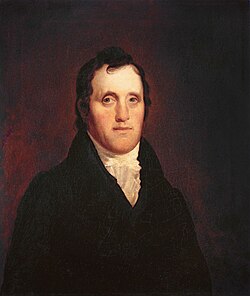| |||||||||||||||||||||||||||||
217 members of the Electoral College 109 electoral votes needed to win | |||||||||||||||||||||||||||||
|---|---|---|---|---|---|---|---|---|---|---|---|---|---|---|---|---|---|---|---|---|---|---|---|---|---|---|---|---|---|
| Turnout | 16.9% [1] | ||||||||||||||||||||||||||||
| |||||||||||||||||||||||||||||
 Presidential election results map. Green denotes states won by Monroe/Tompkins and Salmon denotes states won by King. One elector from Delaware and three from Maryland did not vote. Numbers indicate the number of electoral votes cast by each state. | |||||||||||||||||||||||||||||
| |||||||||||||||||||||||||||||
Presidential elections were held in the United States from November 1 to December 4, 1816. The Democratic-Republican ticket of secretary of state James Monroe and the governor of New York Daniel D. Tompkins defeated the de facto Federalist candidate, the senior U.S. senator from New York Rufus King. [3] Although not formally nominated, King became the last Federalist presidential candidate upon receiving 34 votes from Federalist unpledged electors. [4] In the subsequent election, the Federalists carried three states but did not field their own candidate, instead supporting the incumbent Monroe, before disappearing by the end of the 1820s. [5]
Contents
- Nominations
- Democratic-Republican Party
- Federalist Party
- Campaign issues
- Uncontested election
- Caucus system
- Virginia dynasty
- Results
- Statistics
- Indiana's electoral votes
- Electoral results
- Results by state
- Electoral votes by state
- Maps
- Electoral college selection
- See also
- Notes
- Bibliography
- External links
The outgoing president James Madison did not seek re-election to a third consecutive term. Monroe emerged as the Democratic-Republican frontrunner and secured the party's nomination at its congressional nominating caucus in March, narrowly defeating the secretary of war William H. Crawford. The caucus nominated Tompkins for vice president over the governor of Pennsylvania Simon Snyder. The Federalists were disorganized following the end of the War of 1812 and did not hold a caucus or formally select a candidate. King himself remained aloof from the campaign and did nothing to promote his candidacy. [6] No consensus on a vice presidential candidate emerged among the Federalist electors, who scattered their votes between four candidates. [7]
Monroe benefited from the popularity of the outgoing Madison administration and resurgent nationalism following the end of the war. Madison's 1816 message to Congress endorsed an ambitious economic program that robbed the Federalists of much of their platform, most notably chartering the Second Bank of the United States. [8] In spite of significant discontent with the caucus system and the incumbent Virginia dynasty, the Democratic-Republicans were able to avoid a major factional schism in contrast to the previous election. The Federalists meanwhile were demoralized, dogged by accusations of treason, and ill-prepared to mount a national campaign. [9] Most took Monroe's election for granted and did not attempt to prevent it. [4] In three states where electors were chosen by the legislature, Federalists controlled the selection process and appointed unpledged electors who voted for King. [10] Monroe carried the 16 remaining states, including every state where electors were chosen by popular vote, amidst widespread voter apathy and anemic turnout. [11]












